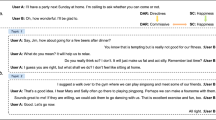Abstract
In some cases, to make a proper translation of an utterance in a dialogue, different pieces of contextual information are needed. Interpreting such utterances often requires dialogue analysis including speech acts and discourse analysis. In this paper, a statistical dialogue analysis model for Korean–English dialogue machine translation based on speech acts is proposed. The model uses syntactic patterns and n-grams of speech acts. The syntactic patterns include surface syntactic features which are related to the language-dependent expressions of speech acts. Speech-act n-grams are used to approximate the context of utterances. The key feature is the use of speech-act n-grams based on hierarchical recency. Experimental results with trigrams show that the proposed model achieves an accuracy of 66.87% for the top candidate and 82.35% for the top three candidates. It indicates that the proposed model based on hierarchical recency outperforms the model based on linear recency.
Similar content being viewed by others
References
Alexandersson, J., E. Maier and N. Reithinger: 1995, ‘A Robust and Efficient Three-Layered Dialogue Component for a Speech-to-Speech Translation System’, In Seventh Conference of the European Chapter of the Association for Computational Linguistics, Dublin, Ireland, pp. 188-193.
Allen, James: 1987, Natural Language Understanding, Benjamin/Cummings, Menlo Park, Ca.
Andernach, Toine: 1996, ‘A Machine Learning Approach to the Classification of Dialogue Utterances’, in NeMLaP-2: Proceedings of the Second International Conference on New Methods in Language Processing, Ankara, Turkey, pp. 98-109.
Austin, J.L.: 1962, How to Do Things with Words, Oxford University Press, Oxford.
Carberry Sandra: 1989, ‘A Pragmatics-Based Approach to Ellipsis Resolution’, Computational Linguistics 15, 75-96.
Choe J.W.: 1996, ‘Tay-hwa-pwun-sek-ey iss-e-se-uy myech-ka-ci mwun-cey: ho-theyl yey-yak cen-hwa-tay-hwa-lul cwung-sim-u-lo’ [Some Issues in Conversational Analysis: Telephone Conversations for Hotel Reservation], in Han-kul Mich Han-kwuk-e Ceng-po-che-li, Taejon, Korea, pp. 7-16.
Grosz, Barbara J. and Candace L. Sidner: 1986, ‘Attention, Intentions, and the Structure of Discourse’, Computational Linguistics 12, 175-204.
Jang S.J.: 1992, ‘Han-kwuk-eMwun-pep - NLP-lulWi-han HPSG/K’, [Korean Grammar - HPSG/K for NLP], technical report CAIR-TR-92-33, Center for Artificial Intelligence Research, KAIST, Taejon, Korea.
Kim J.A., Y.H. Cho, J.W. Lee, and G.C. Kim: 1995, ‘A Response Generation in Dialogue System based on Dialogue Flow Diagrams’, in Proceedings of the Natural Language Processing Pacific Rim Symposium, Seoul, Korea, pp. 634-639.
Kitano, Hiroaki: 1994, Speech-to-Speech Translation: A Massively Parallel Memory-Based Approach, Kluwer Academic Publishers, Dordrecht.
Lee J.W. and G.C. Kim: 1995, ‘A Discourse Analysis Model Using Hybrid Knowledge for Dialogue Machine Translation’, in Proceedings of Natural Language Processing Pacific Rim Symposium, Seoul, Korea, pp. 397-401.
Levin Lori, Oren Glickman, Yan Qu, Donna Gates, Alon Lavie, Carolyn P. Rosé, Carol Van Ess-Dykema, and Alex Waibel: 1995, ‘Using Context in Machine Translation of Spoken Language’, in Proceedings of the Sixth International Conference on Theoretical and Methodological Issues in Machine Translation TMI 95, Leuven, Belgium, pp. 173-187.
Litman, D.J. and J.F. Allen: 1987, ‘A Plan Recognition Model for Subdialogues in Conversations’, Cognitive Science 11, 163-200.
Nagata, M. and T. Morimoto: 1994, ‘First Steps towards Statistical Modeling of Dialogue to Predict the Speech Act Type of the Next Utterance’, Speech Communication 15, 193-203.
Reithinger, Orbert and Elisabeth Maier: 1995, ‘Utilizing Statistical Dialogue Act Processing in Verbmobil’, in 33rd Annual Meeting of the Association for Computational Linguistics, Cambridge, Mass., pp. 116-121.
Seo J.Y., J.W. Lee, J.H. Kim, J.M. Cho, C.H. Kim, and G.C. Kim: 1994, ‘Dialogue Machine Translation Using a Dialogue Model’, in Proceedings of China-Korea Joint Symposium on Machine Translation, Yanbian University, Yanzi, China, pp. 55-63.
Walker, Marilyn A.: 1996, ‘Limited Attention and Discourse Structure’, Computational Linguistics 22, 255-264.
Walker, Marilyn and Steve Whittaker: 1990, ‘Mixed initiative in Dialogue: An Investigation into Discourse Segmentation’, in 28th Annual Meeting of the Association for Computational Linguistics, Pittsburgh, Pa., pp. 70-78.
Waibel A., A. Jain, A. McNair, H. Saito, A. Hauptmann, and J. Tebelskis: 1991, ‘JANUS: A Speechto-speech Translation System Using Connectionist and Symbolic Processing Strategies’, IEEE Proceedings of the 1991 International Conference on Accoustics, Speech, and Signal Processing.
Woods, W.A.: 1970. ‘Transition Network Grammars for Natural Language Analysis’, Communications of the ACM 13, 591-606.
Author information
Authors and Affiliations
Rights and permissions
About this article
Cite this article
Lee, JW., Seo, J. & Kim, G.C. A Statistical Dialogue Analysis Model Based on Speech Acts for Dialogue Machine Translation. Machine Translation 13, 269–286 (1998). https://doi.org/10.1023/A:1008007325490
Issue Date:
DOI: https://doi.org/10.1023/A:1008007325490




